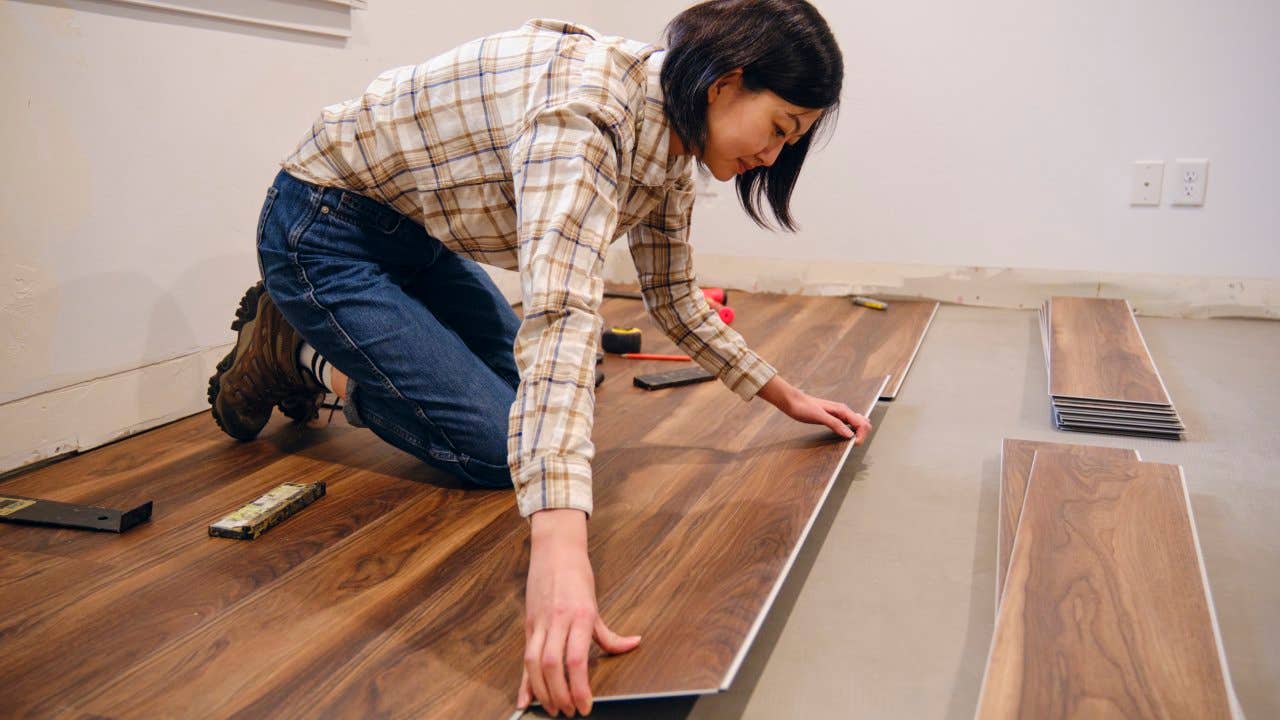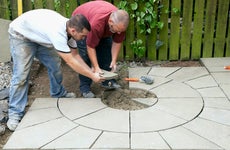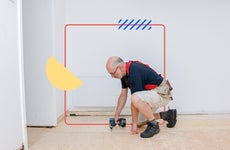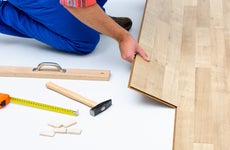How much does flooring installation cost?

The Bankrate promise
At Bankrate we strive to help you make smarter financial decisions. While we adhere to strict , this post may contain references to products from our partners. Here's an explanation for .
So, you’re thinking about putting in new floors. Maybe you’ve always hated your dingy tile or scratched floorboards. Maybe a few decades of kids, pets and parties have finished off that once-nice finish. Or maybe all of the TikTok DIYers have given you some inspo. In any case, you should know that replacing flooring is no easy undertaking.
Nor a cheap one, though the final price of floor installation depends on quite a few factors, from the floors’ size and layout to their current condition to the materials you choose. “Most flooring types will range between $5 and $25 a square foot,” Charlotte Granville, home remodeling specialist at Fixr, says. Overall, it typically works out to anywhere between $1,500 to $8,000 to refloor a house, according to the contractor-search site — with a national average cost of $3,500.
That’s a big range, so let’s get into where your specific project might land. The more you understand what goes into flooring installation, the less likely you are to be floored.
Key takeaways
- The cost to install flooring ranges from $5 and $25 a square foot, with the national average price to refloor a house running $3,500.
- The final price of floor installation depends on several factors, from the floors’ size and layout to their current condition.
- Materials and labor are the most important influences in floor prices. Total installation costs run roughly double to triple the costs of materials alone.
- Aside from some simple click-and-lock jobs, it’s usually recommended to have a pro install flooring.
- New floors’ return on investment ranges from 25% to 118%, depending on material, but a high-quality job can increase a home’s perceived value at resale time.
What influences the cost of installing new floors?
As with most home renovation projects, materials and labor are the Big Two influencers on a floor installation, but you need to go beyond them when you’re trying to budget. Here are a few factors that factor into your overall flooring installation cost.
Removing existing flooring
What are you walking on now? You might have the option to simply put your new floor on top of your old one. David Steckel, Home Expert at Thumbtack, explains: “Your most basic floor is a floating floor.” This sort of floor floats or rests atop your existing surface, often with some kind of underlayment in between the two. Floating floors can be an option with certain material types, including laminate, vinyl and engineered wood.
Otherwise, you’ll have to get rid of what you’ve got. “When replacing the floors, removal costs are usually included in the replacement and reflect the type of material chosen,” Granville says. This can start fairly inexpensive ($.35 for carpet removal) but scale up as more labor is required. Demo-ing tile or stone requires intensive labor, while ripping out carpet can be fairly easy.
Area/size
Since you pay for flooring material by the square foot, it should be no surprise that the number and size of the room(s) impacts your total new flooring cost. The bigger the space, the more material you’ll need, driving your overall project cost up. “A new bathroom floor can cost as little as $250 whereas the costs can reach up to $25,000 for the basement” running the length of the home, Granville notes.
Infrastructural features
Laying the floor anywhere other than a flat surface will drive up cost. If your installer will have to lay flooring on stairs or around columns, navigate a sunken living room, or deal with unusual shapes or dimensions, expect to pay more — both because it’s a more intricate job and because you might need extra or specially cut materials.
Subfloor
The surface square footage isn’t the only thing that matters. You also need to consider what’s going on under the floor you plan to lay. Specifically, is the subfloor — the support structure beneath your flooring, which is layered over the joists— level? And is it adequate to support whatever your new floors will be?
“If you want to put down carpet, it doesn’t matter,” Steckel says. But for any other sort of floor, “the material you choose dictates the levelness requirements. Larger-format flooring requires less deflection. A 5-inch hardwood plank requires the floor to be much more level than a 1.25-inch plank.”
So, as you’re budgeting for your flooring installation cost, factor your subfloor in. “If the existing floors are sunken, creaking or cracked, the subfloor may need replacing, which costs around $3.50 to $12 per square foot,” Granville says.
Underpad
Even if you’re doing a floating floor, you might still want or need something between your old floor and your new one. This underlayment or underpad helps to dampen sound, provide cushion and protect your floors.
It might not just be a nice-to-have, either. “If you’re in a condo or an HOA, you might have an underpad requirement,” Steckel says.
Material
“The type of flooring material significantly impacts the overall installation costs,” Granville explains. “Installing vinyl flooring doesn’t usually exceed $18 per square foot, but expect to pay up to $60 a square foot for high-end marble flooring.”
Plus, whether you’re looking at laminate, vinyl, tile, carpet or any other material, you’ll have options within the category. “There’s always a scale from super cost-effective to premium,” Steckel says.
Home location
Where your house is located matters, and not just because things cost more in different parts of the country. Your climate might preclude you from certain materials. In tropical areas, like Florida, “hardwood floor is not ideal because of humidity,” Steckel offers as an example.
Every house settles and shifts over time, but certain terrains are more uneven and unstable than others. You’d want to avoid material that cracks easily, like marble, in these regions.
If you talk to flooring pros in your area, they can guide you toward materials that are suitable for your local climate and weather patterns.
Labor
The installation itself plays a big role in your overall project price tag, often as much as half the cost. While the floor size and layout affect the difficulty of the install, much depends on the materials: With some substances, like carpet and vinyl click-lock floorboards, labor should be relatively cheap. If you choose a large-format tile (any side larger than 15 inches) that require a high level of precision and strength, or a wood pattern with a lot of intricacy (like currently “in” herringbone or chevron), the extra effort will drive your new flooring cost up.
Usually, flooring installers will give you an estimate for your project. They consider the square footage of the room, the hours they expect the project to take, the type of material — some being more labor-intensive than others — and other factors, like leveling your subfloor or repairing the floor joists, when they give you a quote.
Types of floors
While several factors affect the overall price of replacing a floor, it mainly comes down to the material — both for its own sake and because it influences the time-intensiveness and difficulty of the install. So here’s a baseline estimate by types of material.
These cost estimates, based on figures from Fixr, include the new flooring cost in its entirety (i.e., materials and labor). Figure on prices for the material alone running about one-half to two thirds less, unless it’s a luxe substance (think marble or an exotic wood).
Laminate
A snazzy synthetic, laminate mimics the look of natural materials (usually wood, but also stone or tile) without the higher price point. Installing these floors usually costs somewhere between $6–$14 per square foot.
Hardwood
Hardwood remains king of the floors — the universal symbol of taste and class that goes with every decor (except maybe the industrial-chic look). Solid wood floors usually cost $14–$32 per square foot, admittedly on the high end. But they are an investment: They can last for decades with a little refinishing periodically, are easy to maintain — and actually can be a selling point (see How much does a new floor add to the value of your home?, below).
Engineered wood
Engineered wood consists of a plywood core covered with the veneer of a particular, pricier wood. This hybrid of the natural and the manufactured costs much less than the traditional solid variety, but looks almost as good. You can expect to pay $8–$14 per square foot for your material and flooring installation with engineered hardwood.
Vinyl and linoleum
Vinyl and linoleum flooring has come a long way. You can still get sheets of linoleum or vinyl flooring for an extremely low price point, but if you have a little bit more budget, click-lock vinyl flooring can look a lot like other materials (e.g., wood). Even then, it’s relatively cheap. “Vinyl flooring is probably the most affordable option on the market right now, costing between $2–$18 per square foot installed,” Granville says.
Tile
A perennial favorite for bathrooms, tile costs can range widely depending on where and how the tile was made, what it is made of and how complicated it is to install. Generally, though, you should budget $8–$14 per square foot of tile you want to install.
Stone
Natural stone comes in on the pricier side: Remember that $60 per square foot that Granville mentioned for marble? For more modest options — limestone, slate, granite — you can expect to pay somewhere around $10–$15 per square foot.
Carpeting
With the exception of vinyl and linoleum, carpet takes the cake when it comes to keeping new flooring cost to a minimum (not needing a subfloor is a big savings). Installed, it rings in at $7–$12 per square foot. “It might not be suitable for certain areas of the home, but wall-to-wall carpet is a great option for those on a tighter budget,” Granville says.
DIY flooring installation versus hiring a professional
Not surprisingly, most flooring pros recommend you hire a pro. But seriously, replacing a floor can be a complicated job — especially if sub-floors and joists need work — that requires strength and skill. “The odds are that if you don’t have the tools today and you don’t know exactly how to do the installation without looking online, you shouldn’t be DIY-ing this project,” Steckel says. “Inevitably, it will cost you more in time and money if you don’t hire a pro.”
The main exception might be if you want to go with laminate or another sort of floating floor that clicks and locks into place, as opposed to being glued or nailed to your subfloor, Granville advises. If you do have some skill, tile flooring might not be too tough to install, especially if it’s a simple, small job (like a bathroom). “Most other flooring materials require a professional if you’re looking for long-lasting results,” she says.
How to save on flooring installation costs
The flooring experts we talked to have some tips to keep it to a minimum:
- Work with what you’ve got. “Find a floor thickness and length that accommodates the existing trueness of your substrate,” Steckel says. “If your floors are a little wonky, I would go for more narrow and shorter floorboards. If you’re going longer and wider, you typically need to do glue and nail and that adds cost.” And remember, carpet can work on just about any floor, regardless of how even it is.
- Shop around. “It’s important to shop around when looking to install new floors, ” Granville says, “If you’re going for hardwood flooring, explore all the different options and see where you can save.” Not all hardwoods are created equal — pine is generally one of the least-expensive options, she says — and with creative staining and finishing techniques, even humble maple can look (almost) as good as ritzy mahogany.
- See what’s on sale. Unless you’re in a rush or have your heart set on a certain substance, Steckel recommends periodically checking in with suppliers to see if they have any material they want to get rid of at a discount.
- Keep the pattern simple. If you choose tile, “go for more traditional versus custom patterns,” Steckel says. Stacked (in which the squares are set in simple straight lines) will be cheaper than herringbone, for example.
How much does a new floor add to the value of your home?
Of course, new flooring improves the living and looks of your home, but will you see more practical gains — specifically, a return on investment (ROI) — at resale time? “The value new flooring can bring to a home completely depends on the material,” Granville says. “Hardwood usually results in the best return, but there’s no guarantee of a good ROI.”
Indeed, installing new wood flooring recoups 118 percent of its costs, the National Association of Realtors’ “2022 Remodeling Impact Report” found, and simply refinishing an existing hardwood floor can deliver a notable 147 percent. But most flooring types (like home renovations in general) don’t see an ROI nearly that strong.
| Material | Average ROI |
|---|---|
| Source: Realtor.com | |
| Wood (engineered and solid) | 70–80% |
| Ceramic tile | 70% |
| Stone | 55–70% |
| Porcelain tile | < 55% |
| Marble | 50% |
| Carpet | 25–40% |
Of course, figures aren’t everything. While spending $25,000 on new floors might not literally add $25,000 to your asking price, it’ll certainly enhance the home’s appearance and add to that intangible wow factor. At the very least, since flooring is a fundamental part of a residence, it’ll give buyers a sense the place is in good shape. “It can ultimately influence the perceived quality of the property,” as Renee Marvin, real estate associate with Sotheby’s International Realty – Montecito – Coast Village Road Brokerage, noted in a recent post by the brokerage. “The flooring may affect a future buyer’s decision about the sale price or even the purchase.”
Bottom line on flooring installation costs
How much does flooring cost? By now, you know that it depends. If you’re considering putting in new floors, the best way to get an idea of your specific flooring installation cost is to talk to a few local flooring installers. For starters, they can tell you what materials and labor is likely to cost in your area. Beyond that, they can also advise you on substances that work well in your geography and your options based on your current floor and its condition.
Initial outlay is important, but do think long-term. The more durable floors are often more expensive upfront, but the cost is amortized over the years — and they can stay looking new with minimal refreshment or refinishing, as opposed to a cheaper material that needs a complete replacement a few years down the road.
Related Articles



